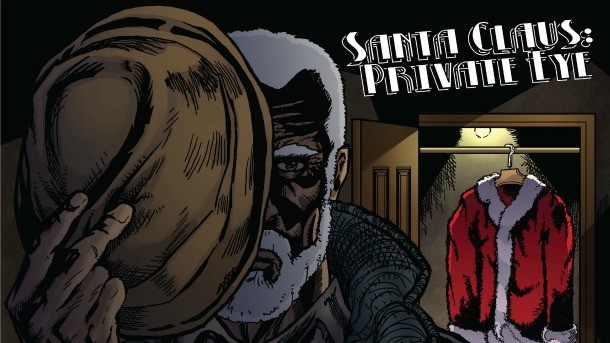Dead Space 2's Writer On The Original Story And Private Eye Santa

Writers like to tell stories so we sat down with Dead Space 2's writer Jeremy Bernstein to talk about the original plot for Dead Space 2, the development of the offbeat Pretty in Pink game, and his new Santa Clause Private Eye comic.

How did you get the gig writing for Dead Space 2?
That was total luck. It happened at GDC. I was there for one of the experimental game summits, not really thinking about AAA game writing at all, when I discovered that an old college friend, someone I hadn’t seen in years, was running a roundtable session on game writing. So I went to surprise him and say hi. But at the round table, there was this guy asking really interesting questions about writing in games. So I introduced myself to him afterwards to offer my personal answers. We fell to talking, I gave him my card, he asked for a writing sample, and boom. Next thing I knew, it turned out he was a senior producer on Dead Space 2 and offered me the job. So yeah. Luck. That said, that luck would never have paid off if I hadn’t done my homework in advance. If I hadn’t had good samples ready to go, then nothing would have ever come of it.
Were there any elements of your original script for Dead Space 2 that the developers weren’t able to incorporate into the game?
Only one that hurts. I should say first that story development on that game was a very collaborative effort. There were a bunch of us in a room – the Senior Producer who’d hired me, Executive Producer, Creative Director, major department heads – and we pretty much all worked out the story together. Then I went off to draft the script. And there was one thing that we came up with in that room that we all loved, but eventually decided we had to kill: the original take on the villain, Hans Tiedemann.
In the final game, Tiedemann is not only the Chief Administrator of the Sprawl, but he is also leading the secret government program to build a new Marker. His goal is to get this Marker up and running, and since Isaac is the only person who can destroy the Marker, he spends the bulk of the game trying to stop Isaac from getting to it. But in the original story, Tiedemann was only Chief Administrator. He was not in charge of the Marker program. He had only reluctantly allowed the Marker program to set up shop on the Sprawl for the money; the Sprawl was going bankrupt, and he did it for the sake of his people. That was his goal: to protect his people. So, when it goes wrong and his people start getting slaughtered by necromorphs, he gets as many survivors as he can – only 100,000 out of the Sprawl’s million inhabitants – into the Government Sector and seals it off before the necromorph infection reaches them. And when Isaac says “You have to let me in so I can get to the Marker,” Tiedemann won’t do it. He won’t endanger those survivors by breaking quarantine, then he warns Isaac that if he tries anything, he has no choice but to stop him. He wasn’t a bad guy trying to build his evil space-zombie device at the expense of a million people. He was a good man trying to protect the few people he still had left. That made him so wonderfully interesting.
We had this great twist, when Isaac finally got to Government Sector…and it turns out nobody else was there. There were no survivors. They had been Marker hallucinations the whole time. Tiedemann was just utterly mad with regret, so it was this wonderful tragedy. He spent all this time trying to stop Isaac to protect his people…who were already gone. Unfortunately, as we started getting into the script, we started running into problems. When all was said and done, he was too sympathetic. You felt bad for the guy, you really did. We realized that what we really wanted was a bad guy you could really hate. Someone whose ass you were really looking forward to kicking in the end. So we turned him around into a more conventional bad guy. But man, part of me still mourns for what might have been there.

We heard that you once worked on the Pretty in Pink game. What was the story there?
My first question when I was offered that gig was 'Ummmmm…who exactly do you think wants to play a Pretty in Pink game?' And without missing a beat they said, 'Thirty-something women who loved the movie growing up and now have teenage daughters they want to share it with.' Which I actually thought was a pretty good answer. So yeah, it was a downloadable, hidden-object game aimed at the casual audience. What was really fun is that we got to restore the original ending of the film. As originally scripted, Andie ended up with Duckie (Jon Cryer) and not Blane (Andrew McCarthy). But, with that ending, the filmmakers felt like the moral of the story had become, 'upper class kids and working class kids can never make it work,' so they changed it so Andie and Blane end up together, and it’s more of a 'love conquers differences' kind of story. Of course, games are all about player choice, so when we found out about that original ending, we were able to work out some gameplay to let the player choose who Andie ended up with.
Have you worked on any projects that never saw the light of day?
I’ve worked on plenty of projects that never quite came together. It’s the nature of the freelance beast. Some of the more interesting included a couple of fitness games, a photo-recognition geo-cache game, an organic chemistry game. The one I regret the most was a social media game that was designed specifically as a companion piece to a video series. We had this great premise on the video side that would have tied seamlessly into the gameplay. We built the engine, playtested prototypes and everything. We just couldn’t quite find the money to take it all the way.
How challenging is the transition from TV writing to video games to comics?
Personally, I’ve had a pretty easy time swinging back and forth. I mean, every medium has its own quirks and tricks. The key to transitioning between them is knowing what makes that medium unique. With games, I’ve not only been gaming my whole life, but I’ve actually worked as a game designer. So I came into game writing with a clear understanding of the requirements and limitations of the medium. Comics were a little more challenging, but in a really fun way. You really have to describe every panel, because the visuals tell the story even more so than in television. Fortunately, I’ve always been a very visual thinker, so I really enjoyed getting to write in that level of detail.
Tell us about your new comic Santa Claus: Private Eye?
Santa: PI delights me no end. It’s a modern, noir detective story, about a down-and-out Saint Nick spending the other 364 days of the year holding his own in the lonely city, just another Jake trying to make ends meet. Instead of a red and white suit, it’s trenchcoat and fedora; instead of the North Pole, it’s dark nights and rain-slicked streets filled with gangster, guns, and femme fatales…and the nicer they look, the naughtier they are. It’s really been a passion project of mine for awhile. I wanted to write a supernatural detective series, but so many of the big supernatural creatures have already been used. Then something in the back of my head just went, 'No one’s done Santa as a detective,' and that was just perfect. Getting to blend all the tropes of Santa Claus with all the tropes of Film Noir was unspeakable fun. Also, I can’t talk about it without talking about my incredible art team, who really made it all come to life: Michael Dorman, the amazing artist. Rob Schwager as colorist, Troy Peteri as letterer, and, of course, Thrillbent for hooking me up with them and publishing it for us.
Santa Clause Private Eye is now available on Thrillbent, a subscription service that give you unlimited webcomics for $3.99 a month.

Get the Game Informer Print Edition!
Explore your favorite games in premium print format, delivered to your door.
- 10 issues per year
- Only $4.80 per issue
- Full digital magazine archive access
- Since 1991









